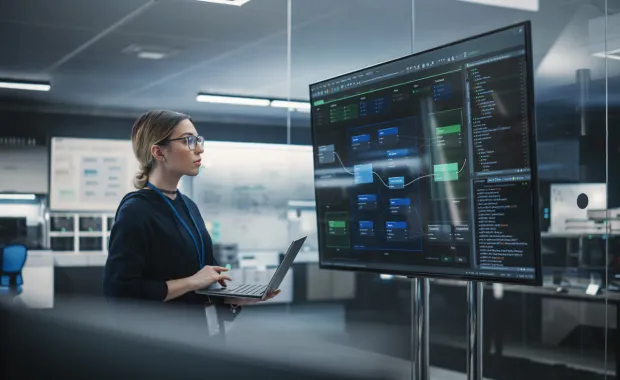Cloud technology is transforming rail safety, enabling proactive measures such as predictive maintenance, real-time monitoring, and rapid incident response, all crucial for safeguarding passengers and employees. Building on my previous blog about the rail sector’s shift to the cloud, I’ll now explore how cloud solutions go beyond streamlining operations to significantly enhancing safety across the network.
Proactive safety and reliability through cloud-driven insights
Cloud platforms, combined with integrated systems, consolidate critical data and alerts into a single version of truth. Sensors on rolling-stock, tracks, signals and other critical infrastructure components are continuously monitored, providing real-time insights to control centres. Whether addressing track anomalies, or managing out-of-service station facilities, cloud-first solutions provide immediate support for engineering, passenger service or operational issues, making for a streamlined customer experience.
For example, with CGI SensorInsights360, data captured from sensors on rolling stock can indicate early signs of track deterioration, such as cyclic top, wet beds, or environmental damage. These insights enable timely engineering interventions, addressing issues before they escalate into critical events. Similarly, CGI Machine Vision replaces periodic manual inspections with continuous automated video analysis, providing structural insights by detecting and flagging changes across the network. By adopting a cloud-first approach, these tools play a significant role in enhancing safety and reliability across the rail network.
Predictive maintenance means fewer surprises
By analysing historical and live data, cloud analytics predict potential failures in critical components, allowing early interventions that prevent disruptions and reduce delay penalties. These tools also support root cause analysis and help identify equipment in need of attention. This not only keeps the railway running efficiently, but also reduces the requirement for physical trackside monitoring, keeping boots off ballast and engineers safe.
Rapid incident response through cloud-enabled coordination
When incidents occur, every second counts. Cloud systems connect teams across operations, maintenance, and incident response, ensuring instant access to critical data. Permission based access keeps all relevant services and responders in sync, allowing precise and timely action. Cloud platforms also enhance situational awareness during emergencies by delivering the right information to the right teams at the right time. This coordination improves decision-making and ensures faster, more effective responses, ultimately strengthening safety outcomes across the network.
Centralising data for seamless collaboration
Cloud systems make sharing data between different teams or external partners simpler and more efficient. Maintenance records, sensor data, or emergency reports, are all stored securely and are easy to access with the correct permissions. This ensures all parties are working with the same up-to-date information and helps teams avoid confusion or miscommunications. This centralisation also improves collaboration and ensures that all stakeholders, including contractors or regulatory bodies, have access to the same safety-critical information.
Staying compliant with safety regulations
Rail safety goes beyond technology, it’s also about maintaining compliance with strict industry regulations. Cloud systems simplify the tracking and reporting of safety measures, helping operators adhere to these critical standards. Some of the key regulations include:
- ROGS (Railways and other guided transport systems regulations 2006): Requires operators in the UK to maintain a Safety Management System (SMS). Cloud platforms simplify tracking risks, incidents, and inspections, making it easier to stay compliant.
- ISO 55001 – Asset Management: This standard ensures infrastructure is well-maintained. Cloud systems enhance operators asset management efficiency and help them meet these safety requirements.
- Cybersecurity and data protection regulations: Protecting sensitive data is critical. Cloud providers offer strong security features, like encryption and 24/7 monitoring, keeping important safety data safe from cyber threats.
By using cloud systems to stay on top of regulations, operators can focus on the job of keeping railways safe.
Future-proofing rail safety with cloud innovation
As the rail industry continues to embrace new technologies, the cloud provides a scalable foundation for adopting innovations like AI-driven monitoring or advanced data analytics, allowing operators to improve safety without overhauling existing systems. Additionally, built-in security features such as encryption, access controls, and constant monitoring, ensure safety-critical data remains protected from cyber threats. By providing a flexible and secure framework, cloud solutions empower the rail industry to adapt to future challenges and advancements with confidence.
Conclusion
Cloud technology is redefining rail safety by enabling operators to anticipate and prevent issues, respond swiftly to emergencies, and maintain compliance with critical regulations. As the industry progresses its cloud-first strategies, continuous evaluation of technology and capabilities will be vital to stay ahead of the curve. By embracing cloud solutions, operators can create safer, more reliable rail systems for passengers and employees alike.
To learn more about how we can support your cloud journey in the rail industry, please get in touch.







